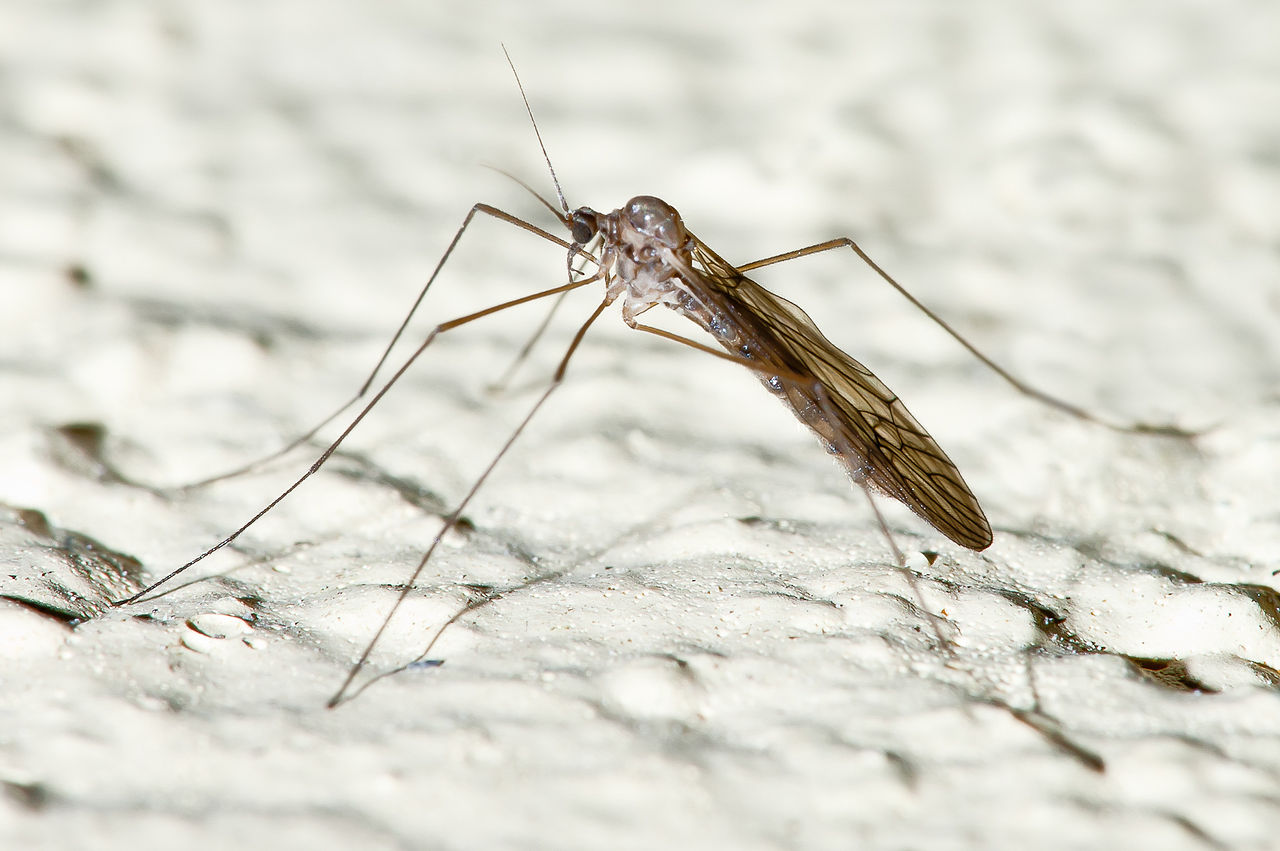- Home
- Garden Wildlife
- Insects
- True flies
- Root-eating flies
Root-eating flies
Several fly families have larvae that live in the soil and feed on live plant roots. These include the Tipulidae, otherwise known as crane flies or daddy-longlegs. There are also some flies in the Anthomyiidae and Psilidae (rust flies) that will come to the attention of vegetable growers.
Species in Britain and Ireland
The Tipulidae has nearly 90 species in Britain and Ireland. The larval stages are commonly known as leatherjackets. Larvae can develop in a range of habitats including rotten wood, wet soils ponds and lakes. Some species feed on the roots of turf and can cause problems in lawns. Turf feeders include Tipula paludosa, Tipula oleracea and Nephrotoma appendiculata.
Crane flies are easily recognised because of their long spindly legs, narrow elongate bodies and long narrow wings. While they are commonly called "daddy long-legs", this term is best avoided because it is also used for the unrelated harvestmen and the cellar spiders. Emerging adult crane flies are one of the signs of early autumn, and they regularly scare the uninitiated because of their size, tickly legs and rather weird appearance. They are completely harmless and rather pathetic fliers.
The larger crane flies are about 25-30mm in length and they can have a wing span of up to 40mm. The tubular larvae are greyish brown in colour and have a tough outer skin, hence the name ‘leatherjacket’. The larvae have no obvious head and the rear end has a number of small projections known as anal papillae. The larvae are up to 45mm long when fully grown. The larvae of many species feed on the roots and stem bases of grasses and other plants, other species feed on decomposing organic matter or algae. The adult flies are short-lived and do not appear to feed.
The winter gnat Trichocera annulata is a common garden insect in the family Trichoceridae, which look similar to and are are closely related to the crane flies. They are much smaller, and males perform in mating swarms in sun patches in winter months.
Of the 26 Psilidae species in the British Isles, only the carrot fly Chamaepsila rosae is likely to be noticed by gardeners. Its larvae are a serious pest of carrots and related vegetables. Carrot fly has a black body, 5-6mm long, with pale coloured legs. The slender larvae are yellowish orange, up to 7mm long, and they tunnel in the roots of carrot, parsnip, celery, celeriac and parsley, as well as those of some related wildflowers.
Leatherjacket larva of crane fly Tipula sp. Winter gnat Trichocera annulata
There are 244 species of Anthomyiidae in Britain and Ireland, but only a minority adversely affect garden plants. Delia radicum, the cabbage root fly, has larvae that devour the roots of brassicas and related plants such as turnip, swede and radish. Delia antiqua, the onion fly, causes similar damage to roots and bulbs of onions, shallots and leeks. The adults of onion fly and cabbage root fly resemble house flies in size and colour. Their white larvae are up to 9mm long.
Carrot fly Chamaepsila rosae adult fly, and larval damage to carrot crop
Life cycle
Female crane flies dip the tip of their abdomens into the soil to deposit clusters of eggs, which hatch a few weeks later. In some species eggs are laid in early autumn, with the young larvae overwintering and completing their feeding in the following spring or summer. Those species that lay eggs in early summer may have completed their larval feeding by autumn and will overwinter as pupae. When the adult fly is ready to emerge, the pupal stage wriggles upwards until it protrudes out of the soil. Empty pupal cases are sometimes seen in large numbers on lawns in late summer-early autumn.
While crane flies generally have a single generation a year, those of carrot fly, onion fly and cabbage root fly have at least two and sometimes three. These flies detect their host plants by scent and deposit eggs in the soil close by. The larvae feed initially on fine root hairs but later eat the larger roots or tunnel inside the fleshy tap roots. When fully fed, the larvae pupate in the soil. Onion fly and cabbage root fly overwinter as pupae, but larvae of the last generation of carrot fly can carry on feeding well into the winter.
Role of root-eating flies in gardens
While some flies have larvae that are unwelcome in gardens, their abundance at certain times of year means that they are important prey items for predatory animals such as bats, spiders and some birds. This is particularly true for crane flies, which are often present in large numbers in late summer and early autumn.
Most crane flies do not cause garden problems, however those that do are mainly a problem in lawns. Damage typically occurs in years when wet weather coincides with the egg-laying period, which ensures better survival of the eggs and young larvae. Leatherjackets can move from lawns into adjacent flower beds or vegetable plots and may damage young plants growing there.
Flies with larvae that eat the roots of vegetables can make growing vulnerable vegetables difficult. Young brassica plant are often killed by cabbage root fly, as are onions and leeks by onion fly larvae. A large proportion of the carrot crop can be rendered inedible by carrot fly tunnelling. There are some carrot cultivars that are sold as being resistant to carrot fly but ‘less susceptible’ is a better description. There are no pesticides currently available for garden use that will give effective control of these insects, so growing vulnerable vegetables under insect-proof netting is the best means of preventing losses.
Other sources of information
Websites
RHS information on leatherjackets
RHS information on onion fly
RHS information on cabbage root fly
RHS information on carrot fly
Books
Coe, R.L, Freeman P. and Mattingley P.F. (1950) Handbooks for the Identification of British Insects. Diptera 2.Nematocera: families Tipulidae to Chironomidae. Tipulidae 1. Out of print but available here.
Stubbs, A E. (2021) British Craneflies British Entomological and Natural History Society
Page text drafted by Andrew Halstead, reviewed by Andrew Salisbury, compiled by Steve Head
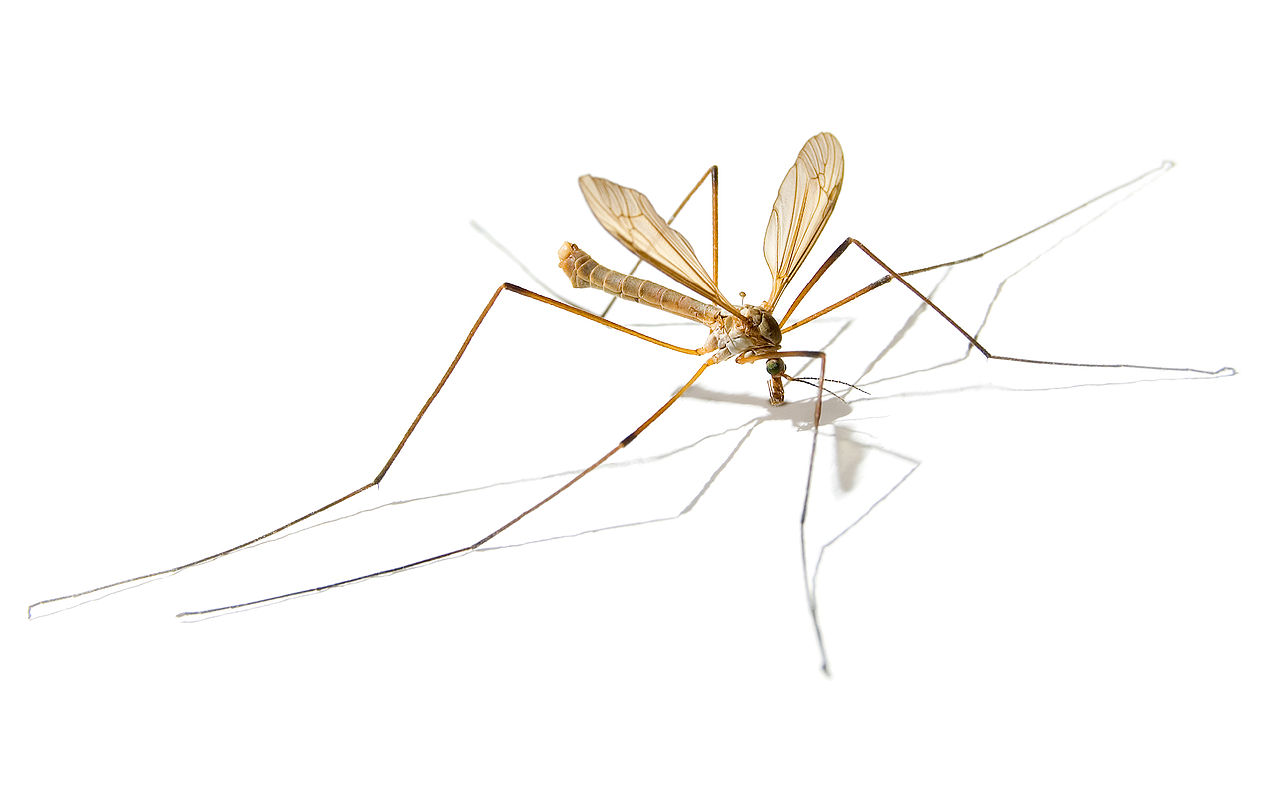
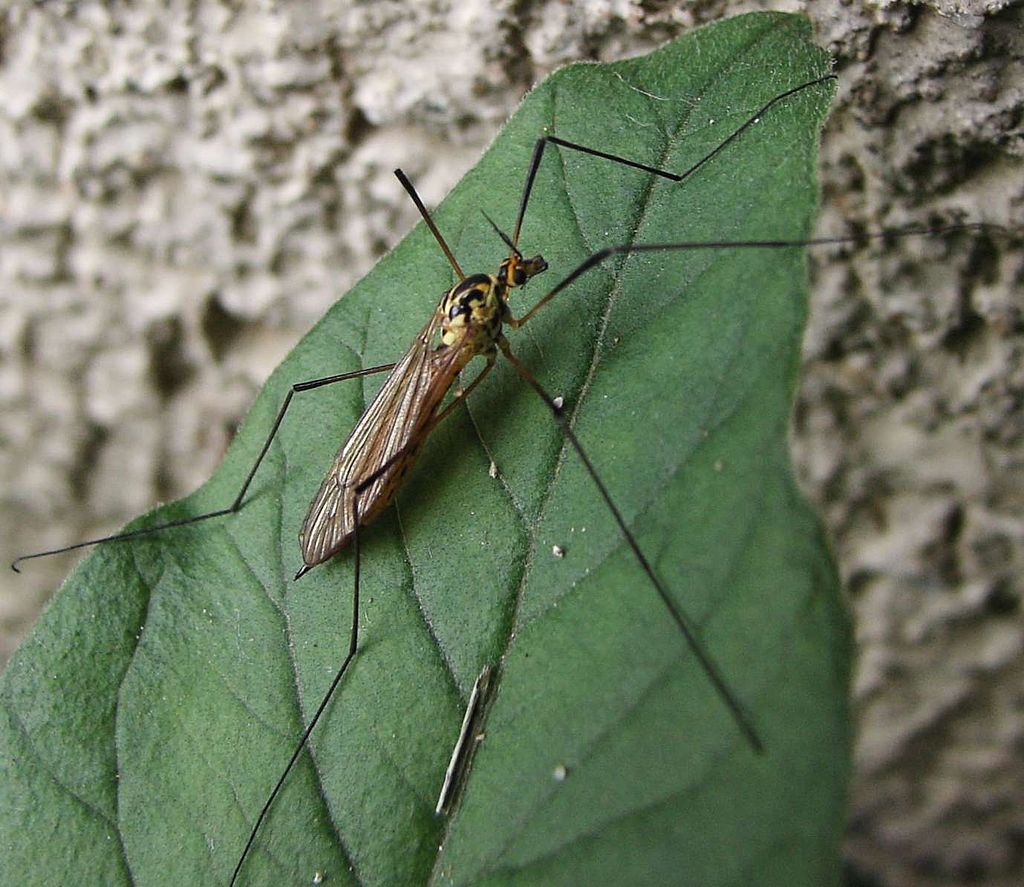
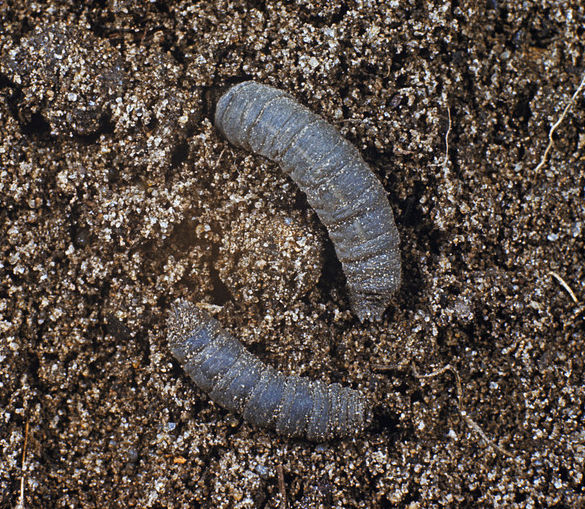
Crane fly Tipula paludosa Spotted cranefly Nephrotoma appendiculata
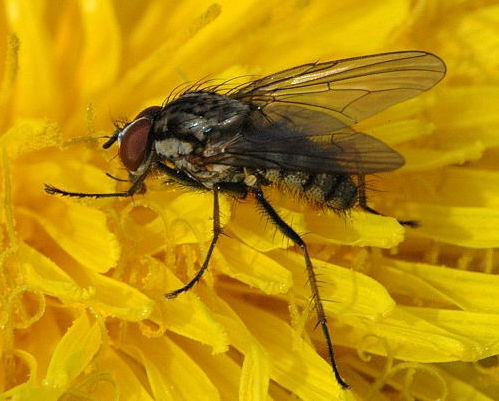
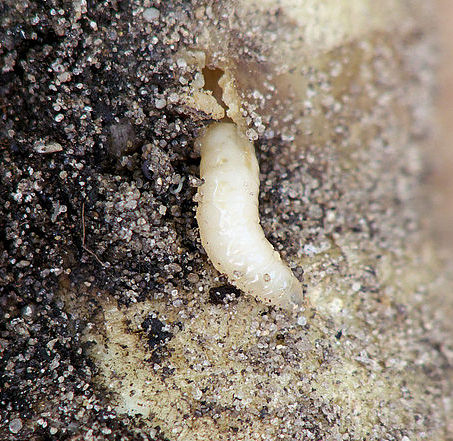
Above: Cabbage root fly Delia radicum Adult fly and larva
Left: onion destroyed by onion fly larvae Delia antiqua
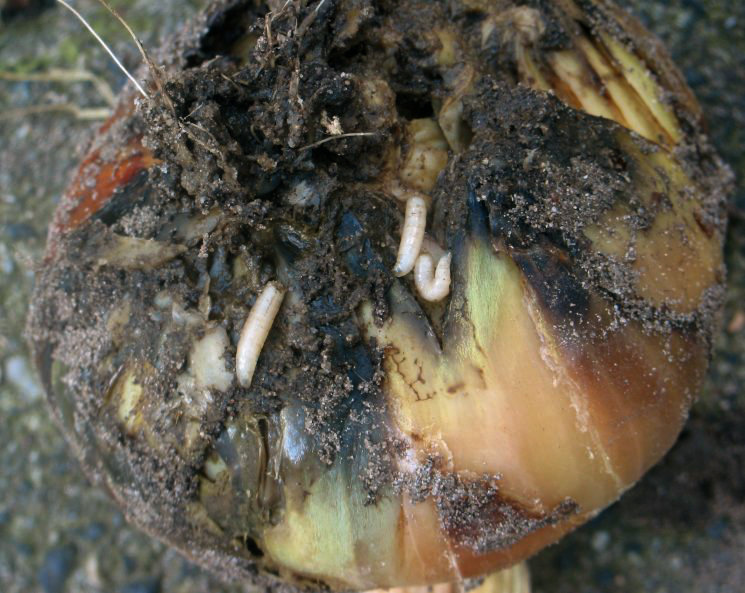
.jpg)
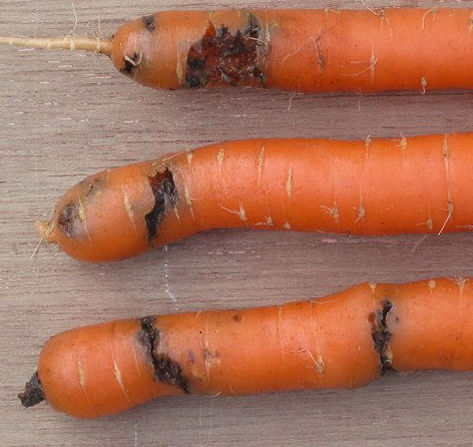
Root-eating flies
Several fly families have larvae that live in the soil and feed on live plant roots. These include the Tipulidae, otherwise known as crane flies or daddy-longlegs. There are also some flies in the Anthomyiidae and Psilidae (rust flies) that will come to the attention of vegetable growers.
Species in Britain and Ireland
The Tipulidae has nearly 90 species in Britain and Ireland. The larval stages are commonly known as leatherjackets. Larvae can develop in a range of habitats including rotten wood, wet soils ponds and lakes. Some species feed on the roots of turf and can cause problems in lawns. Turf feeders include Tipula paludosa, Tipula oleracea and Nephrotoma appendiculata.
Crane flies are easily recognised because of their long spindly legs, narrow elongate bodies and long narrow wings. While they are commonly called "daddy long-legs", this term is best avoided because it is also used for the unrelated harvestmen and the cellar spiders. Emerging adult crane flies are one of the signs of early autumn, and they regularly scare the uninitiated because of their size, tickly legs and rather weird appearance. They are completely harmless and rather pathetic fliers.
The larger crane flies are about 25-30mm in length and they can have a wing span of up to 40mm. The tubular larvae are greyish brown in colour and have a tough outer skin, hence the name ‘leatherjacket’. The larvae have no obvious head and the rear end has a number of small projections known as anal papillae. The larvae are up to 45mm long when fully grown. The larvae of many species feed on the roots and stem bases of grasses and other plants, other species feed on decomposing organic matter or algae. The adult flies are short-lived and do not appear to feed.
The winter gnat Trichocera annulata is a common garden insect in the family Trichoceridae, which look similar to and are are closely related to the crane flies. They are much smaller, and males perform in mating swarms in sun patches in winter months.


Crane fly Tipula paludosa Spotted cranefly Nephrotoma appendiculata




Above: Cabbage root fly Delia radicum Adult flyand larva
Left: onion destroyed by onion fly larvae Delia antiqua
Of the 26 Psilidae species in the British Isles, only the carrot fly Chamaepsila rosae is likely to be noticed by gardeners. Its larvae are a serious pest of carrots and related vegetables. Carrot fly has a black body, 5-6mm long, with pale coloured legs. The slender larvae are yellowish orange, up to 7mm long, and they tunnel in the roots of carrot, parsnip, celery, celeriac and parsley, as well as those of some related wildflowers.
.jpg)

Carrot fly Chamaepsila rosae adult fly, and larval damage to carrot crop
Life cycle
Female crane flies dip the tip of their abdomens into the soil to deposit clusters of eggs, which hatch a few weeks later. In some species eggs are laid in early autumn, with the young larvae overwintering and completing their feeding in the following spring or summer. Those species that lay eggs in early summer may have completed their larval feeding by autumn and will overwinter as pupae. When the adult fly is ready to emerge, the pupal stage wriggles upwards until it protrudes out of the soil. Empty pupal cases are sometimes seen in large numbers on lawns in late summer-early autumn.
While crane flies generally have a single generation a year, those of carrot fly, onion fly and cabbage root fly have at least two and sometimes three. These flies detect their host plants by scent and deposit eggs in the soil close by. The larvae feed initially on fine root hairs but later eat the larger roots or tunnel inside the fleshy tap roots. When fully fed, the larvae pupate in the soil. Onion fly and cabbage root fly overwinter as pupae, but larvae of the last generation of carrot fly can carry on feeding well into the winter.
Role of root-eating flies in gardens
While some flies have larvae that are unwelcome in gardens, their abundance at certain times of year means that they are important prey items for predatory animals such as bats, spiders and some birds. This is particularly true for crane flies, which are often present in large numbers in late summer and early autumn.
Most crane flies do not cause garden problems, however those that do are mainly a problem in lawns. Damage typically occurs in years when wet weather coincides with the egg-laying period, which ensures better survival of the eggs and young larvae. Leatherjackets can move from lawns into adjacent flower beds or vegetable plots and may damage young plants growing there.
Flies with larvae that eat the roots of vegetables can make growing vulnerable vegetables difficult. Young brassica plant are often killed by cabbage root fly, as are onions and leeks by onion fly larvae. A large proportion of the carrot crop can be rendered inedible by carrot fly tunnelling. There are some carrot cultivars that are sold as being resistant to carrot fly but ‘less susceptible’ is a better description.
There are no pesticides currently available for garden use that will give effective control of these insects, so growing vulnerable vegetables under insect-proof netting is the best means of preventing losses.
Other sources of information
Websites
Books
Coe, R.L, Freeman P. and Mattingley P.F. (1950) Handbooks for the Identification of British Insects. Diptera 2.Nematocera: families Tipulidae to Chironomidae. Tipulidae 1. Out of print but available here.
Stubbs, A E. (2021) British Craneflies British Entomological and Natural History Society
Page text drafted by Andrew Halstead, reviewed by Andrew Salisbury, compiled by Steve Head
Leatherjacket larva of crane fly Tipula sp. Winter gnat Trichocera annulata
There are 244 species of Anthomyiidae in Britain and Ireland, but only a minority adversely affect garden plants. Delia radicum, the cabbage root fly, has larvae that devour the roots of brassicas and related plants such as turnip, swede and radish. Delia antiqua, the onion fly, causes similar damage to roots and bulbs of onions, shallots and leeks. The adults of onion fly and cabbage root fly resemble house flies in size and colour. Their white larvae are up to 9mm long.
Leatherjacket larva of crane fly Tipula sp. Winter gnat Trichocera annulata
There are 244 species of Anthomyiidae in Britain and Ireland, but only a minority adversely affect garden plants. Delia radicum, the cabbage root fly, has larvae that devour the roots of brassicas and related plants such as turnip, swede and radish. Delia antiqua, the onion fly, causes similar damage to roots and bulbs of onions, shallots and leeks. The adults of onion fly and cabbage root fly resemble house flies in size and colour. Their white larvae are up to 9mm long.
